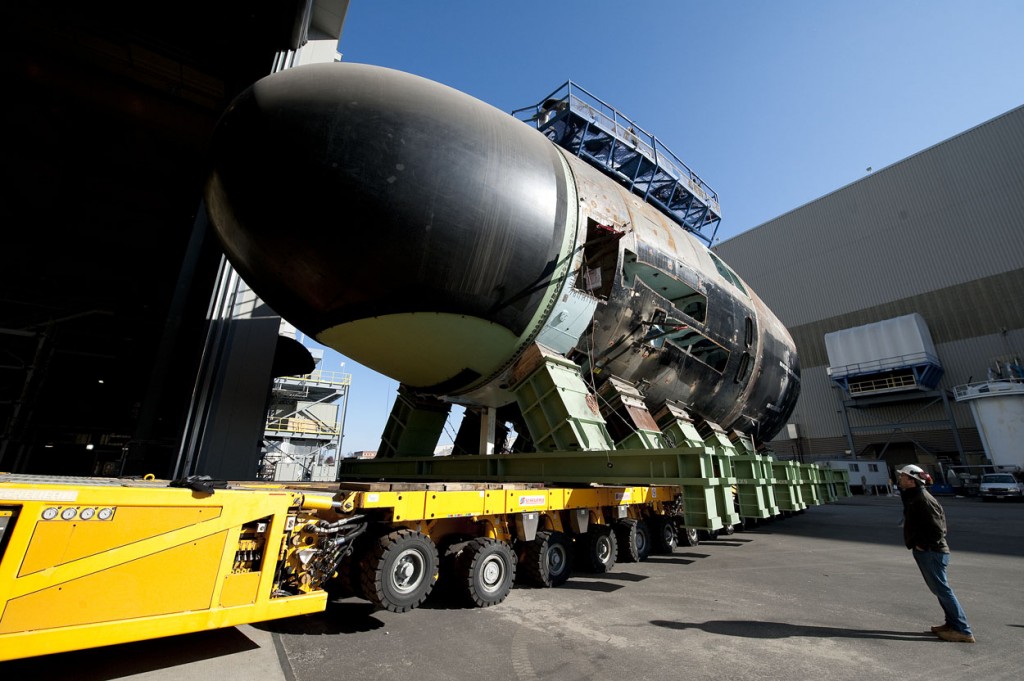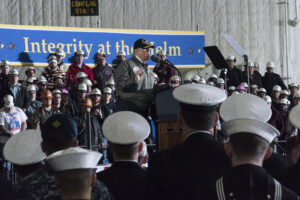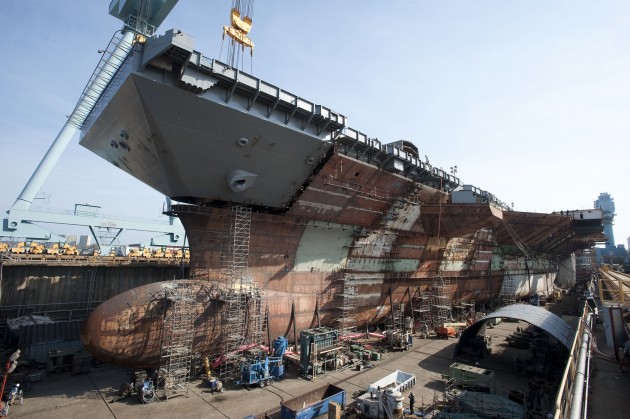The $13 billion supercarrier USS Ford under construction in Newport News, Va.
CAPITOL HILL: Despite the impressive $61 billion increase for defense in the omnibus appropriations bill that just passed the House, seapower subcommittee leaders are saying they want more money for more ships.

Rep. Todd Wittman
“We had $26.2 billion in the authorization (bill), and in the appropriation they have $23.8 billion,” seapower chairman Rob Wittman told me and another reporter this morning outside an Aircraft Carrier Industrial Base Coalition Breakfast. While he voted for the omnibus, he disagrees with the appropriators’ decision to change the authorizer’s numbers, so “I want to be constructively critical,” he said. “I spoke with leadership about it to let them know of my concern.”
Wait — doesn’t this omnibus fund 14 new ships for the Navy, compared to 13 in the National Defense Authorization Act and just eight in President Trump’s request? Yes, but not all ships are created equal, Wittman said.
“What I want to make sure is we are actually counting warships,” Wittman said. “So it’s great to say there’s 14 ships there, but one of those ships is an oceanographic survey ship — it’s not a warship. The other is essentially a glorified tug.”
“Effectively, you could say that it’s 12,” he added, which would mean the omnibus is one warship less than the NDAA. “It depends on how you count the ships.”
The omnibus also doesn’t allocate as much as the NDDA for Advanced Procurement of various vessels. “AP” is a time-honored technique to both reduce overall costs — buying certain materials and components in advance saves money –and spread the cost of a ship over multiple years. In particular, Wittman told us after speaking to the carrier contractors, there’s “not quite as much as money in advanced procurement for aircraft carriers as we would like.”

The USS Warner under construction in Newport News, one of the last two shipyards in the US able to build a nuclear-powered submarine.
According to the subcommittee’s ranking Democrat, Joe Courtney, the omnibus also falls slightly short on advanced procurement for nuclear-powered submarines — whose industrial base overlaps with that of nuclear-powered carriers. While the omnibus went higher than the Senate appropriators, allocating $225 million in sub AP as opposed to the Senates’ $175, “we need to go even a little bit higher than that,” Courtney told me.
Wittman also said that, at $225 million, advanced procurement money for submarines was below what the authorizers thought necessary.

Rep. Joe Courtney aboard the aircraft carrier USS TRUMAN.
“Having said that,” Courtney hastened to say, “I’m very excited” that the omnibus allows the Navy to negotiate a multi-year procurement contract for 13 submarines over five years instead of 10. “That was my amendment actually before the appropriations committee,” he said, adding with a laugh: “Negotiating with the appropriations staff sometimes can be as challenging as partisan negotiation. When they talk about multi-year stuff, they get kind of antsy.”
The other big block buy on the table, announced just this week, is the Navy’s Request For Proposal to buy two supercarriers on a single contract. If finalized, the multi-year procurement would accelerate carrier construction from one flattop every five-plus years to one every three-and-half. Industry says that’s a more cost-effective pace because they don’t have to ramp up their workforce for one flattop and then idle it again waiting for work to start on the next.
Counter-intuitively, building carriers faster also helps build more submarines, Courtney said, citing arguments by Assistant Navy Secretary James Geurts. On the original plan, the nuclear industrial base would have to build a new carrier at the same time it was ramping up submarine production to three a year — either two Virginia attack boats and a huge Columbia-class nuclear missile sub, or three Virginias. On the accelerated schedule, the carriers come before and after the ramp-up in subs.
While we’re speeding up production, however, Wittman and Courtney warned that we’re retiring old Los Angeles subs and Nimitz carriers almost as fast. Even as submarine production rises, the number of attack boats in service will drop, while the carrier fleet will hover around 11. It’ll rise to the congressionally mandated 12 carriers in 2023, only to drop immediately as the next Nimitz-class retires.

President Trump speaks to Newport News Shipbuilding employees above the carrier FORD.
“Despite all the increase in hiring (at the shipyards) and increased block buys, we’re still going to have this trough in the submarine fleet and the same goes for carriers,” Courtney warned. “Shipbuilding’s a long game — there is no longer game than building carriers….We’re not going to see a 12-carrier fleet anytime in the Trump administration, whether it’s one term or two.”
“I do think we can put ourselves on a path to 12 carriers, but it will not happen in a short period of time,” Wittman told me. “It’s realistic to expect that you could get there in a 20-year time frame….We’d like to push the envelope on that, but I think 20 years is probably about right.”
Of course, all these long-term plans depend on Congress providing long-term funding. The current budget deal raises Budget Control Act caps on spending for two years, but after that, “sequester comes back in ’20,” Wittman warned. “You can’t just say, ‘we rest on our laurels’ in ’18 and ’19, because ’20-’21 is the biggest challenge out there to get us on a sustainable path.”
And of course, 2020 is a presidential election year. Presumably, President Trump will be running for reelection — a surefire partisan fireworks show that may hobble legislative business.
Measure
Measure
